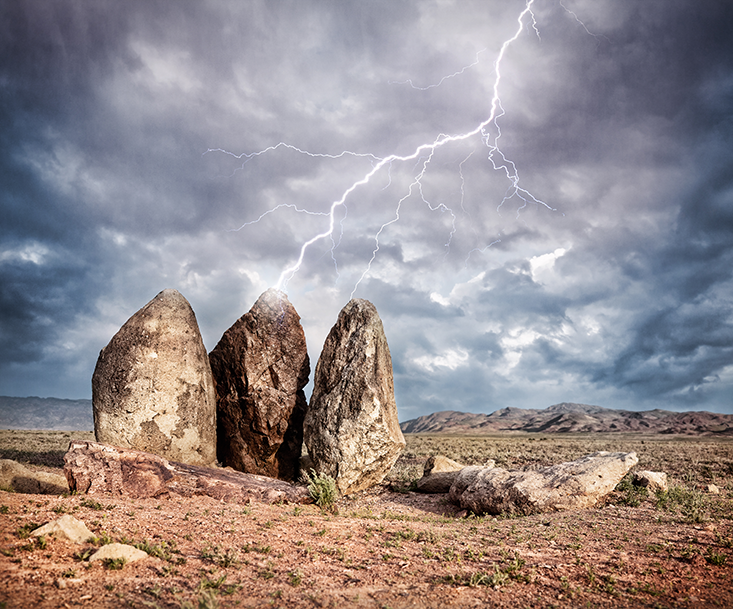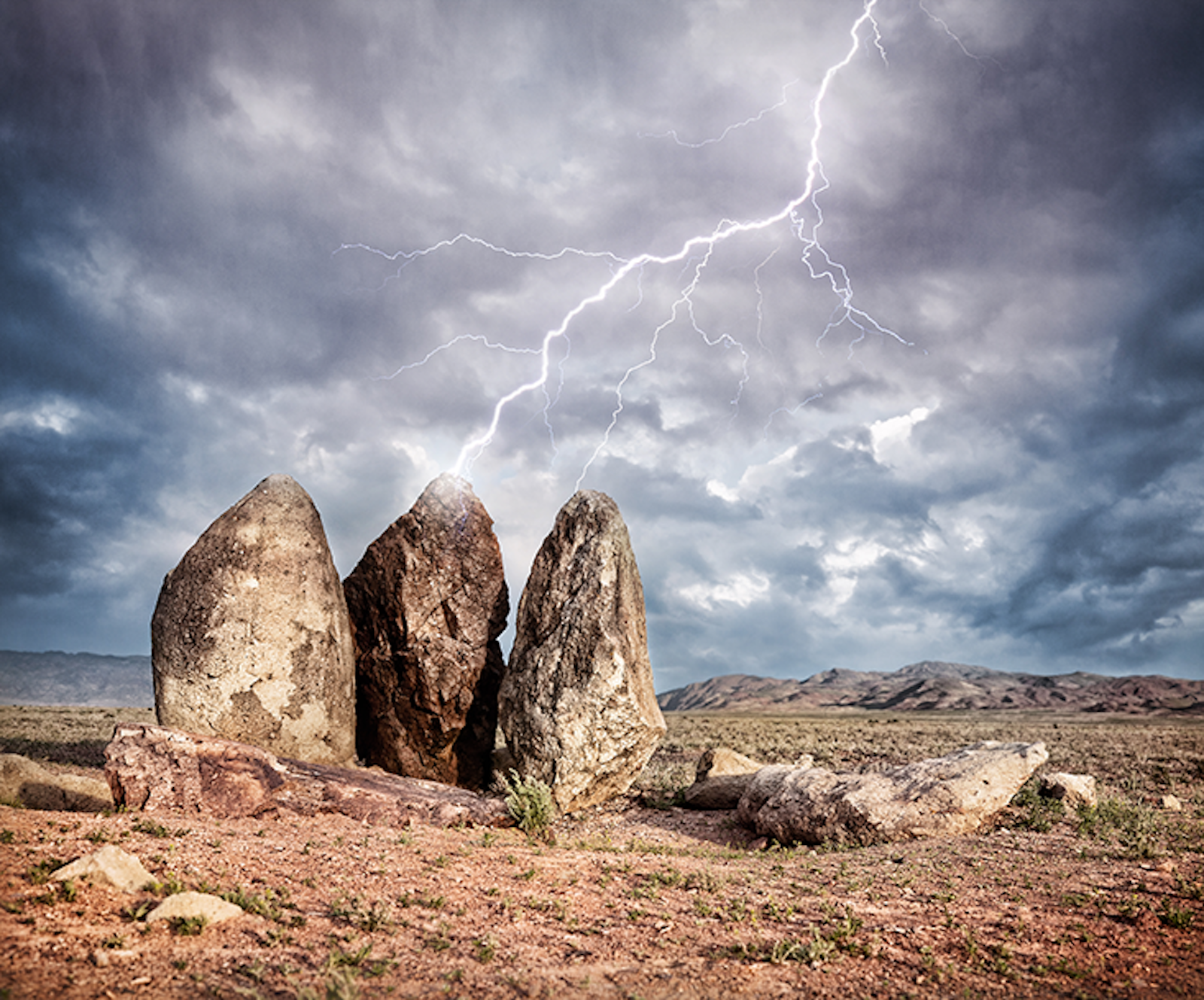Stephen McGreevy looked nervously at the sky. Outside his camper van in Nevada’s Black Rock Desert, angry black clouds gathered on the horizon as 30-mile-per-hour winds whipped across the flat expanse. At his feet, an array of copper wire—hundreds of feet of it—writhed like snakes. As rain beat against the roof, McGreevy hastily gathered the cable, shoved it in the van among a tangle of recording equipment, and hit the road. He was headed for Oregon, where he planned to have the array set up again before dawn in hopes of capturing strange sounds from the sky.
The noises he was hunting were first discovered in the early days of radio. Soldiers on field telephones at the front lines of World War I would say that, some days, you could really hear the grenades fly—the staccato pops and falling whistles coming through the wire sounded like enemy fire. Their true source, however, was long an object of conjecture. Newspapers, for instance, touted them as extraterrestrial voices.
Today researchers understand these sounds to be the product of very low frequency (VLF) waves—radio frequencies with wavelengths from 10 to 100 kilometers. They are generated by natural phenomena—mostly thunderstorms, but also volcanoes and tornadoes. During a thunderstorm, for instance, lightning emits electromagnetic waves that are distinct from the clap of thunder; they travel not at the speed of sound, but at the speed of light. The effect is a chorus of tones:
static “sferics”
sharp “tweeks”
and rare, otherworldly “whistlers.”
McGreevy belongs to a subculture of “natural radio” devotees, who listen to, record, and meticulously collect these rare and beautiful sounds. They trade schematics, make their own equipment, and sometimes travel great distances to find the best listening areas. Just as astronomers seek out the few dark places left on Earth, amateur VLF hunters try to find the last few places without electrical interference. Power lines produce a drone, incessant as the buzzing of a fly, that drowns out natural noise. The prime locations therefore are isolated spots—the wastelands of the southwest, Canada’s tundra and prairies, Oregon’s Alvord Desert.
The result is more than an exquisite library of natural noise. VLF recordings offer a way to observe the behavior of the electromagnetic spaces surrounding Earth. The distinctive whistler, for example, is the signature of energy traveling through the magnetosphere, Earth’s magnetic field. The sound occurs when radiation from lightning, attracted to charged particles in the magnetosphere, shoots out into space along magnetic field lines. As they follow these curved trajectories back toward Earth, the electromagnetic waves disperse, like light refracted in a prism. The higher frequencies reenter the atmosphere first, and the rest follow in a descending cadence—hence the whistle.
Sferics and tweeks, meanwhile, are products of storm energy reflected by the ionosphere, the layer of charged particles reaching 1,000 kilometers above Earth’s surface. Sferics dominate during the day, crackling like white noise—each static hiss from a lightning bolt up to thousands of miles away. At night, however, conditions in the ionosphere shift, channeling energy from even greater distances and stretching the hisses into tweeks.

There are also practical reasons to study VLF waves. They may, for example, prove useful in satellite communications. As VLF radiation travels through the magnetosphere, it appears to reduce the number of charged particles, which can damage satellite electronics. A fuller understanding of this process could enable engineers to extend the life of satellites by sending man-made VLF waves into space. At the same time, telecommunications experts are looking at VLF waves for carrying voice calls and data. Because long waves require large antennas for transmission and reception, size is a problem. But the ability of these waves to travel vast distances is appealing. Recently, an ambitious project in Alaska, funded in part by the U.S. Defense Advanced Research Projects Agency (DARPA), used an array of 180 antennas to harness the current in the ionosphere that drives the aurora borealis (northern lights), allowing researchers to communicate with nuclear submarines on the other side of the world.
Although scientists have studied VLF waves for decades, it is difficult to rival the zeal of the dedicated amateur. Mike Midecke, an early VLF radio devotee, recalls being invited in the late 1980s to Stanford University, where, in the spirit of glasnost, Soviet and U.S. scientists convened in a basement to listen to one another’s VLF recordings. Pleased but baffled, Midecke asked why he was there. “Why?” responded Stanford’s senior scientist. “You’re one of maybe 200 people on Earth who knows anything about this stuff.”
Slowly, that has changed. Beginning in 1989, Midecke got involved in NASA’s INSPIRE project, which gives American schoolchildren access to VLF receiver technology. For his part, McGreevy, a kind of Alan Lomax of natural radio, has found a receptive audience beyond middle-aged radio enthusiasts. He has designed a portable “whip” antenna, similar to the radio antenna on the hood of a car, that makes VLF recording much less daunting than when it demanded a large wire array. He estimates that some of his antenna schematics have been downloaded more than 50,000 times.
But although the amateurs have come together and grown as a community over the years, listening remains an individual pursuit. “When you go out there, you get a sense of solitude,” McGreevy says. “People are on their own.”
Back in Oregon’s Alvord Desert, the sun began to rise. McGreevy rolled 2,000 feet of wire over sand and sagebrush. Across the world, a bolt of lightning struck. Through his headphones came a sound like a laser beam. He turned on his tape recorder and, for a moment, it seemed as if the earth was speaking just to him.
Sound recordings courtesy of The INSPIRE Project.






























